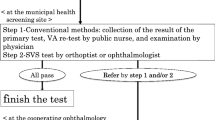Abstract
Purpose
In Japan a basic preparatory ophthalmic examination is routinely performed for 3-year-old children. This study aimed to determine the value of incorporating a photoscreener into the examination and evaluate parents’ satisfaction with the photoscreener examination.
Study design
Prospective study.
Methods
Children aged 42–47 months in Nagasaki City, Japan, underwent a visual acuity test by a parent at home and by automated vision screening using a photoscreener at their local municipal health center between October 2018 and March 2019. Subjects were children referred to Nagasaki University Hospital for examination after failing either test. Children previously diagnosed with strabismus and/or amblyopia were excluded. A questionnaire survey evaluated the level of satisfaction with the photoscreener-based screening by parents who attended these examinations at the local municipal health center.
Results
Of children who completed the two tests, 52 (failed visual acuity test, 3; failed photoscreener examination, 49) were referred for examination. Of the 49 photoscreener failures, 12 were diagnosed with amblyopia: unilateral amblyopia with anisometropic hyperopia in 10 (83.3%), and bilateral amblyopia with astigmatism and hyperopia in 2 (16.7%). The photoscreener detected all 12 cases of amblyopia, whereas the home-based visual acuity test detected only two cases. More than 80% of 1035 parents were satisfied with the photoscreener examination.
Conclusion
Unilateral amblyopia with anisometropic hyperopia was easily overlooked with the home-based test but was detectable by photoscreener examination. The photoscreener proved to be an effective screening tool for amblyopia in children and was considered a satisfactory examination by a high proportion of parents.


Similar content being viewed by others
Change history
09 April 2022
A Correction to this paper has been published: https://doi.org/10.1007/s10384-022-00917-0
References
Magramm I. Amblyopia: etiology, detection, and treatment. Pediatr Rev. 1992;13:7–14.
Holmes JM, Lazar EL, Melia BM, Astle WF, Dagi LR, Donahue SP, et al. Effect of age on response to amblyopia treatment in children. Arch Ophthalmol. 2011;129:1451–7.
Miller JM, Lessin HR. Instrument-based pediatric vision screening policy statement. Pediatrics. 2012;130:983–6.
Silbert DI, Matta NS. Performance of the Spot vision screener for the detection of amblyopia risk factors in children. J AAPOS. 2014;18:169–72.
Garry GA, Donahue SP. Validation of Spot screening device for amblyopia risk factors. J AAPOS. 2014;18:476–80.
Peterseim MM, Papa CE, Wilson ME, Davidson JD, Shtessel M, Husain M, et al. The effectiveness of the Spot Vision Screener in detecting amblyopia risk factors. J AAPOS. 2014;18:539–42.
Shion H, Sachiko N, Takafumi M, Fuki S, Miki N, Chie U, et al. The effects of refraction test in vision screening for 3-year-old children in Japan: A systematic review. Folia Jpn de Ophthalmol Clin. 2019;12:373–7.
Arnold RW, Armitage MD. Performance of four new photoscreeners on pediatric patients with high risk amblyopia. J Pediatr Ophthalmol Strabismus. 2014;51:46–52.
Japanese Association for Strabismus and Amblyopia. Spot Vision Screener manual for pediatricians Ver.1. 2018. https://www.jasa-web.jp/wp/wp.../c5558d166af88c14173a1f5e24a2771e.pdf. Accessed 1/8 2020.
Multi-ethnic Pediatric Eye Disease Study Group. Prevalence of amblyopia and strabismus in African American and Hispanic children ages 6 to 72 months the multi-ethnic pediatric eye disease study. Ophthalmology. 2008;115:1229-36.e1.
Mariko I, Miwako T, Yukari K, Anri K, Hirotaka I. Cases of overlooked amblyopia in the health examination for 3-year-old children. Folia Ophthalmol Jpn. 2017;10:153–6.
Chikako W, Ayumi K, Yuri O, Sayaka M, Miyuki S, Mayumi S, et al. Overlook of amblyopia at the health examination for three-year-old children. Jpn Orthopt J. 2007;36:125–31.
Force UPST. Vision screening for children 1 to 5 years of age: US Preventive Services Task Force Recommendation statement. Pediatrics. 2011;127:340–6.
Tatara S, Maeda F, Mizuno N, Noguchi A, Yaoeda K, Abe H. Refraction and pupil diameter in 3-year- and 1-month-old children as measured by Spot Vision Screener. Sci Rep. 2019;9:15622.
Sachiko N, Mai O, Shiho A, Shizuka K, Marina N, Tetsuya K, et al. The results of 3-years-old children’s visual screening over the past 11 years in Matuse City. Folia Jpn de Ophthalmol Clin. 2020;13:357–60.
Bregman J, Donahue SP. Validation of photoscreening technology in the general pediatrics office: a prospective study. J AAPOS. 2016;20:153–8.
Ying GS, Maguire MG, Cyert LA, Ciner E, Quinn GE, Kulp MT, et al. Prevalence of vision disorders by racial and ethnic group among children participating in head start. Ophthalmology. 2014;121:630–6.
Arana Mendez M, Arguello L, Martinez J, Salas Vargas M, Alvarado Rodriguez AM, Papa CE, et al. Evaluation of the Spot Vision Screener in young children in Costa Rica. J AAPOS. 2015;19:441–4.
Forcina BD, Peterseim MM, Wilson ME, Cheeseman EW, Feldman S, Marzolf AL, et al. Performance of the spot vision screener in children younger than 3 years of age. Am J Ophthalmol. 2017;178:79–83.
Acknowledgements
We thank the community-based welfare section of Nagasaki City Government for their generous support.
Author information
Authors and Affiliations
Corresponding author
Ethics declarations
Conflicts of interest
S. Harada, None; Y. Nakashima, None; M. Uematsu, None; S. Morimoto, None; Y. H. Mohamed, None; T. Kitaoka, None; H. Moriuchi, None.
Additional information
Publisher's Note
Springer Nature remains neutral with regard to jurisdictional claims in published maps and institutional affiliations.
Corresponding author: Masafumi Uematsu.
About this article
Cite this article
Harada, S., Nakashima, Y., Uematsu, M. et al. Effectiveness of a photoscreener in identifying undiagnosed unilateral amblyopia at vision screening of 3-year-old children in Japan. Jpn J Ophthalmol 66, 193–198 (2022). https://doi.org/10.1007/s10384-021-00896-8
Received:
Accepted:
Published:
Issue Date:
DOI: https://doi.org/10.1007/s10384-021-00896-8




